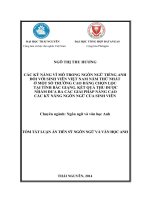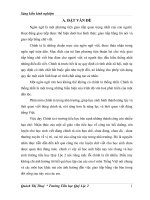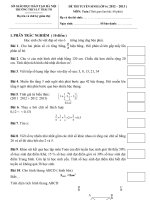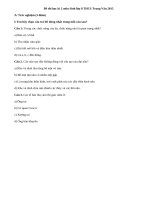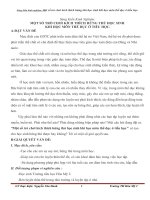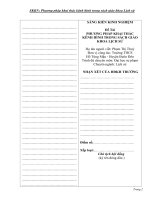Kinh nghiệm để giúp học sinh yếu kém hứng thú trong việc học tiếng anh đối với học sinh lớp 7 THCS trung chính
Bạn đang xem bản rút gọn của tài liệu. Xem và tải ngay bản đầy đủ của tài liệu tại đây (301.31 KB, 17 trang )
I. HEADING
1. Reason for choosing the topic:
English is an important subject for today's students because
English is not just one of the major subjects that have been
introduced in elementary school but are also an important
language for students to follow. This can easily find many good
jobs or have the opportunity to study abroad. To achieve this right
from junior high school students must acquire basic knowledge.
Is a teacher teaching English at Trung Chinh Secondary school more than k14
years, very well attended by colleagues, monitored the progress of
the lesson, the way teachers go to class, the learning activities of
students ....... I am really worried because most of the lessons
teach the teacher only the good students. Most of the students
are good at active work, in contrast weak students just sitting,
yawning short, yawning, lying down on the table
These limitations in the teaching process not only to me but how
many teachers concern, headaches. Because of that, I was
inspired to research and find ways to teach how to make 100% of
students actively develop the article, I was bravely put forward
"Experience to help weak students with learning English in
Secondary school”. I hope the following article will help my
teachers are full of energy and enthusiasm to continue his difficult
but extremely noble oars.
2. Purpose of the topic.
The purpose of this project is to give some experiences to
help students with learning difficulties.
3. Research subjects and research scope.
a. research object
Grade 7B student- Class is weak. Trung Chinh Secondary
School, Nong Cong.
b. Research scope.
The scope of the research is to help weak students with
learning in English for 7B students who I teach directly at Trung
Chinh High School
4. Research Methodology
Under current conditions, teaching methods that are
innovative in teaching methodology should first focus on the
development of teacher activity plans and students implement
these plans to do so. Active students are encouraged to learn
1
English in the 7 th grade, aiming to actively promote students'
learning activities, which must be thoroughly mastered at all
stages, from teacher preparation In-class instruction to assess
students' learning outcomes. Specifically:
1. Prepare to teach
2. Methods of using paintings, photographs
3. Real things to teach when possible
4. Method of action description
5. Application of information technology
II. CONTENT
1. Theoretical basis
As we know for the current Textbook program, each unit of
unit has too many vocabulary. This has been making students feel
"bored" and anxious, especially for weak students. To overcome
this situation, in the process of giving out the number of words or
teaching them to apply them to each sentence structure in the
lesson, in the lessons, I try to find many methods (avoid the
situation Use the simple teacher-only method to write vocabulary,
Vietnamese meaning, or just the formula on the board and the
students copy it to the text), so that they feel more excited and
more effective in the process. learn.
2. The real situation
English is a subject that requires students to work hard,
invest a lot of time, have to learn methods. Currently, the quality
of learning English is still low due to many reasons. Parents,
students are not aware of the importance of the subject, so there
is no investment time, effort not overcome hard study, many
students do not focus attention, home Do not try hard to learn to
be able to progress.
In addition, along with the economic development, there
are many types of entertainment and entertainment - especially
Game-line has attracted a large number of students, has been
"poisoned", consuming know How much time is spent on student
learning, how many students are dying, how much learning is
taking place. This also contributes to students learning a variety of
subjects including English. So how to excite students interested in
learning English and limiting the number of students studying
weak?
2.1. Initial Investigation.
2
I personally recognize the importance of innovation in
teaching methods, especially the experience of weak students. For
students in grade 7B - this is the class I teach - which is one of the
high school entrance exams - it will also be the basis for students
to progress to the next grade is good or not. To Therefore, it is
necessary to give each student confidence in himself or herself
with a thorough, practical, specific and effective guide. Before
going into this topic, I examine the quality with the following
results.
At the beginning of the 2016-2017 school year, I was
teaching English at the weakest grade of the 7 th grade. By the
beginning of the year, I had the following results:
Block 7: Total: 30 students
Good point: 0 = 0%
Good point: 0 = 0%
Average point: 11 = 36.6%
Weakness: 19 = 63.3%
2.2 Teaching and learning English.
Through the process of investigating and collecting
information, I found that in the teaching of teachers and the
learning of students are still some shortcomings, the quality of
students is low.
2.2.1.Student status of the student.
As we have seen, there are many students who are
passionate about learning English. Some of them are interested in
learning English and are particularly active in foreign language
teaching hours. Foreign language proficiency, partly due to the
effort of studying themselves.
Besides, there are many children who are shy or fearful when they
come to learn foreign languages. Have you confided that I do not
dare to say a sentence in English because I fear mistakes.A few
children do not dare to raise their hands out for fear of saying
wrong, you laugh, teachers critic..Some children say : I do not
understand why at home I learn to belong to the board and then
on the board again forget.
2.2.2 Teaching status.
The teaching of English teachers is still using the old
method, the traditional method, the theoretical interpretation, the
language analysis, not to deepen the training of students'
3
language skills.Therefore will cause Pressure on students, making
them afraid to say, fear of error, resulting in limited capital can
not develop other skills.
So we are teaching foreign languages we need to consider them
to promote their self-study or at least actively in the hours of learning foreign
languages.
We also know that foreign language teachers now have more and
more teaching methods. Teachers guide teachers in addition to
introducing general teaching methods and teaching instructions,
In-class tutoring allows teachers to select the most effective
teaching methods while promoting their self-learning role in the
learning process.
But the best approach is that every teacher personally finds
out through a process of inquiry, experimenting on the basis of
theoretical knowledge of foreign language teaching.
Throughout the years of teaching, I have noticed a weak student
performance on the subject
English is the most common language from the poor, not
grasp the grammar, pronunciation is not standard, the skill set
sentence structure is limited and weakest listening skills. Through
the sincere comments of my colleagues, the opinions of the Board
of Trustees and some of the experiences I have drawn through the
years of teaching English in 7th grade, I would like to present
some methods of promoting students. Weakness in learning
English.
3. Solutions to problems.
3.1 Preparation of the paper.
This is an important first step before entering a unit, at the
beginning of the year when teaching a class, I showed them how
to use the dictionary to see the meaning and pronunciation (or
look up the words). vocabulary at the back of the book at each
unit of study). When they do well, especially the weak students, I
often encourage them by praising the children in front of the class
or sometimes adding points when they can speak Vietnamese or
justify the new word. . When I find out that a certain student is
making some progress, I suggest that the students instruct the
other students to be weaker than themselves to progress
together.
4
3.2 Use real objects in lessons when possible.
This is the most practical, simple and effective method of
teaching.
Before entering the unit, I would like to take the next class or
bring it in the class, sometimes I ask the children in the
preparation of the new vocabulary. Look and prepare the real
thing when possible. When using this method not only do teachers
spend a lot of time preparing teaching aids but also the students
are excited, the lessons are effective. than.
a. Example 1: Unit 2 - English 7- part 1 / page 19
Real: a small toy desk phone
-The teacher gives a phone and asks:
What's this?
-Student A: It's a telephone.
- Student phone call: Is it a telephone?
- Student B: Yes, it is
A telephone
- Teacher (just holding the phone just described
the action to teach the meaning of the verb call): People use
a telephone to call someone. Now repeat please "call", who can
say what call means?
- Student C: It means to call
-Good Teacher: Good.
- Teacher: (pointing to the phone just say) There are a lot of
numbers on the telephone. Can you read numbers from one to
nine?
- Student D: One, ......... nine
Then the teacher can continue to use the phone to teach
the children how to read the phone number, how to ask and
answer the phone number of his friend or someone ... In the
process for the children to practice, I Call the students repeatedly
or give them a phone number and ask if they can read the phone
number. Sometimes to change me for the children to read any
phone number and ask others to remember and write up on the
board. When I do this, I help weaker students become more
confident in discovering that sometimes they can ask questions
for their classmates better.
b. Example 2: Real objects: rulers, books, ...... in class.
5
(Language focus 1 -part 4 - English 7).
-The teacher raised the ruler and asked:
What's this?
-Student A: It's a ruler
-The teacher gives a book and asks: Is this a ruler?
- Student B: No. It is a book
a ruler
- This time I used two things to review the prepositions indicate
where they have learned. To give attention to all the students in
the class, I put the ruler on the book and asked:
-Writer: Where is the ruler?
- Student: It is on the book
- This time I put the ruler under the book and asked
Where is the ruler?
- Student: It is under the book .......
To change the teacher can use other things to both the
attention to help boring and help them remember the simple
things in the class that they have learned. When I saw that they
were in the precepts of the place I had studied, I called the weak
students to use their expressions, and to say its place. Finally I let
the children look at the book and emulate the position of the cat
in the paper.
3.3 / Method of using pictures
English textbooks are mostly written in 4 skills: Listening,
Speaking, Reading, Writing. Each skill in each unit of study has a
clear, vivid illustration. This gives the teacher an illustrated
example of his or her lesson. At the same time it gives students
curiosity, imagination helps them to promote the positive learning,
the
Therefore, besides the use of real objects in the lessons, the
method used pictures equally effective.
In addition to the images available in the textbook, images can be added to or
downloaded from the web.
Example: Unit 3 - English 7 - part 1- page 29
In this lesson I have prepared some pictures in the lesson: home, living
room, bathroom, kitchen and some kitchen utensils. When there are some simple
pictures, sometimes the teacher suggests using some gifted students to help.
+ The teacher takes the house and asks:
6
Teacher: What can you see in the picture?
- Student: A house.
- Teacher: Is it lovely?
- Student: Yes, it is
- Teacher: The house is lovely or I can say
"What a lovely home!"
a house
I let the children write the formula of the exclamation
formula into the set, also using the method of communication, I
put the children on the board to take pictures of the house, living
room, bathroom and kitchen. Then I let the students take all 4
photos and let them know quickly which room they are. When
applying this method, I initially gave the students the weak pupil,
students pretty answer, then I let the children do the opposite.
.
a living room
a bath room
a kitchen
- Student A: (up on the board, call another friend to give the
picture and quick reply)
- Student A: (take the picture of the living room)
- Student B: living room.
- Student A: (give each picture left)
- Students B: bathroom, kitchen, house ....
When they noticed that they had the four words, similarly
using that method, I showed them the pictures of the items in the
article. When they were mature, I gave the first one what the
picture was, the second gave the comment by using the
exclamation. As students practice, I often let students study
poorly, quiz the students pretty well with simple sentences, and
when they give the children attention, I let them ask their friends
for help. Helping the whole class to help each other make
progress.
- student A: This is an armchair
- Student B: An armchair is big.
What a big armchair! ............ .
.
7
- Student C: (take the picture of the bath and ask)
What's this?
D: It's a tub.What a beautiful tub!
an armchair
To change my method for a child to introduce something,
the second child heard and must figure out which image is the
picture and also use the exclamation to make a comment. When
using this method besides the children can remember the content
of the lesson, the children can be trained in listening and speaking
skills.
- Student A: Where is a shower?
- Student B: (give the shower picture,
look at the picture and comment)
It's here. Oh. What a nice shower! ....
In addition to creating opportunities for students
I have the opportunity to practice more, I call students
Give a picture to introduce or use an exclamation,
a
shower
The students have to say their remarks.
Sometimes I suggest that the children deliberately say
wrong to other children to comment and give the correct answer.
- Student A: (This is an electric stove) This is an electric stove
- Student B: Yes, that's right.
- Student C: (bring orange juice) What a delicious orange juice!
- Student D: No, you are wrong, what delicious orange juice! ......
3.4 / Method of action description
This is a method that often makes the classroom exciting
and effective. Teachers can use the action to describe or ask the
students to describe the other children guess and answer, this
method not only application when the vocabulary but also can use
it when teaching grammar.
a. Example 1: Unit 6 - English 7 - part 1- page 60
- Teacher: Describe the action as holding the book as you read it
- What am I doing?
- Student: You are reading.
8
- Teacher: I usually read books after school. How about you? What
do you usually do after school?
After asking the question, I let the students practice in
groups. Each group represented a student describing an action,
another group guessing what it was doing. The group that guesses
more words correctly, the group will win.
- Group A: (using two hands as playing games)
- Group B: You usually play the games after school.
- Group C: (expressed as playing volleyball)
- Group D: You often play volleyball ....
To change the method I called the two students up on the
board; One child asked, the other just described the action, he
raised the question of looking at the expression of his friend that
gave the appropriate answer.
- Student A: What do you usually do after school?
- Student B: (Expressed as written)
- Student A: You usually write a letter
- Student B: You are right ... ..
Then for the children to practice more, I let the children ask
each other what they usually do at other times such as: weekend,
Sunday, evening ...... Also I let another child express, another
child guess What do you usually do?
-A male student: (expressing as listening to music)
-Student A: He often sings a song.
- A female student: (expressing as walking)
- Student B: She often walks.
-Two students: (holding two oranges)
- Student C: They often eat oranges ......
While practicing this method, I give the students a great
deal of attention by first asking them to express their actions to
others, to give their comments. Gradually I let the students
answer to guess their friend's actions.
Example 2: Unit 9 - English 7 - Simple Past tense
When teaching the past simple, the method of expressing
action, later
when giving the formula I applied for a student to express; a
student asks you (or her, he, many) what has been done in the
past, another student answers. When giving the formula I applied
9
for a student to express; A student asks you (or her, him, many)
what has been done in the past, another student answers.
+ Common verb forms:
- Student A: (Expressed as cooking)
- Student B: What did you do?
- Student A: I cooked ......
- Student C: (holding the hat expression as listening to music)
- D: What did he do?
Student E: He listened to music ......
+The "to be"
- Student E: (Expressed as hot)
-Friends: How were you?
-E student: I was hot ......
- Two students: (Express as warm).
- Student G: How were Ha and Nam?
- Students H: They were warm ...
Similarly, I asked the students one question, one answer,
this time I asked the students to use the question and answer
method in the form Yes - No also use the past tense.
- Student A: (Expressed as a ride).
- Student B: Did he drive?
- Student C: Yes, he did.
I called two other students, this time I asked them to use another
verb.
- D: Did he ride?
- Student E: No, he did not drive. He drove ... ..
To change me to the children just described the action, just set the
sentence too
The past began with yesterday. Or maybe a student described,
another student said what he did. Sometimes I let the children
deliberately say wrong to the other corrected ...
- Student A: (just described and said) - Yesterday, I read a
newspaper.
- Student B: Yes, you are right.
- Student C: (just described and said) - Yesterday, I read a
newspaper.
- student D: No, you wrote a letter ......
- Student E: (expressed as having a sad affair)
10
- Student F: Yesterday, she was happy.
- Student G: No, she was not happy. She was unhappy ......
Teachers can also take action, but this time they ask each
other what they did yesterday, last night or the last two days. In
addition to checking their writing skills, I gave a child a description
of the action, the other said and wrote on the board for the class
to comment. Teachers can also take action, but the answer is quiz,
choose True False ....
When using this form I can test grammar, vocabulary in
writing skills, without making them feel bored.
- Student A: (Expression as drawing).
- The teacher gives the answer on the board and asks the
students to choose.
a.Yesterday, She stoped
b.Yesterday, She stopped
c.Yesterday, She stop…...
3.5 / Application Information Technology:
As we all know, the vigorous development of Information
Technology has a positive impact on every activity of our lives.
Informatics has been knocking on many fronts, including
Education. This has contributed to meeting the requirements of
education reform in the current period, especially in teaching
English Secondary schools in the country. When using this
method, I can let the children relax in the classroom with
language games, pictures, sounds and use a variety of exercises
that stimulate the excitement and passion of the students. . In
addition, information technology also allows us to perform more
functions such as: bringing native language into the unit to help
them have better pronunciation, create good sound, music
Melancholy in each lesson, enrich the lessons taught effectively.
Example: Unit 8 - English 7
Using information technology, teachers can let them play crossword games
by filling words, looking at pictures, adding words to words, matching words with
correct words, transcribing English words with Vietnamese meanings, arranging
letters To make the words meaningful, choose Lucky numbers, with these types of
exercises the teacher can check vocabulary for the children without making them
feel bored. In addition, teachers can apply other language games such as Chain
Game, Guessing Game, Word Square, Simon says, Rub out and remember, Slap the
11
board, Find someone who, Answers given, Ordering statements, Odering
vocabulary, Picture drill, Networks, survey, Bingo, Pelmanism ....
+ In the current English program, there are a lot of conversations
in the unit, and the text is making the students, especially the
students, very nervous. Because of this when teaching after each
conversation or paragraph, through the method of applying
information technology, I can let the students do the exercises as
True-False; fill in the conversation, paragraph; Answer
questions ...... so that they can master the content of the lesson
more effectively. By doing this, students can memorize their
lessons in class and the class becomes more animated.
Moreover, information technology also allows students to look at
the sentence patterns, do a variety of grammar exercises such as
selecting tests, looking at pictures and suggestions to make.
Teachers can also use the form of exercises to arrange words into
sentences, make sentences according to suggestions, words with
different pronunciations or accents ... or other types of exercises
which according to the content of each lesson the teacher can
More creatively.
4. Results:
When using a variety of methods to apply in the classes
taught in the class I mentioned above. I realized that the students
in my class were more interested and had better results. In the
first year of the 7th grade (7B-grade) exam, my grade level was
only about 30% average, compared with 65% in the first semester.
Sometimes I questioned the students through the question:
How do you feel about English classes in the Secondary
English program?
a. Excited
b.Normal
C. Bored
For students in grade 7B total of 30 students achieved the
following results:
Before applying the tricks to consolidate learning
12
Total
6
%
25,6
Normal
10
30,8
Bored
14
43,6
Excited
This same subject after a period of application of the procedure
Total
20
%
82,1
Normal
8
10,3
Bored
2
7,7
Excited
Thus, we can see that the number of students excited by
this class has increased markedly. Having said that, it must be
said that there is a great contribution to the method of teaching
appropriate, in particular the application. Flexible teaching tips to
inspire students. Today teachers as the organizers, guidance, help,
supplement knowledge. Students actively acquire knowledge as
the subject of the activity, thus encouraging the enthusiastic
study, actively exploring, exploring the exploitation of knowledge
to train thinking ability and self-learning consciousness. Studying
their knowledge is also part of helping them to grasp the contents
of the class. Moreover, after each lesson, students' knowledge on
cultural knowledge, social science ... is expanded so that students
have the interest in learning the children are really active, bright
"It is necessary to encourage and encourage the teachers,
especially the weak students," which is the general aspirations of
the students, especially the students are weak.
* Comparison results:
After one year of doing so, I have attracted students to my lesson,
they are aware of the learning and importance of English. The
results are quite satisfactory.
13
In the second semester, I surveyed the quality
results as follows:
Tỷ
Tỷ
Tỷ
Lớp TSHS Giỏi lệ Khá lệ T.B lệ Yếu
(%)
(%)
(%)
7B 30
0
0
5
30
21 36,6 4
and statistical
Tỷ
Tỷ
lệ Kém lệ
(%)
(%)
6,6 0
0
Through the application of this experience, the organization
of group activities improves, the skills of listening - speaking reading - writing of students better than before, especially the
skills to do. I feel that the quality of students is increasing, they
are more confident in communicating with teachers, expressing
their opinions when meeting difficulties or having problems.
III. CONCLUSIONS AND RECOMMENDATIONS
1.Conclusion
A successful lesson depends on many factors, but one of
the decisive factors is the way the class is organized. The rhythm
of the lesson must have a two-way interaction between the
student and the teacher. In addition to effective teaching the
teacher needs to create an English-speaking environment in the
classroom. It depends a lot on the English language skills of
teachers in the teaching process. But the use of English as a way
to achieve the purpose of teaching is not to make them feel
"shocked" and create the English language environment from
which to stimulate learning to them is a difficult problem. . In my
opinion, our students here are junior high school students, so we
should not use too many English in one lecture. Select specific
activities for each lesson, avoiding the students do not understand
what to do. To check, the teacher usually speaks in English and
then needs to ask again if the student understands the
requirements or if any problems need to be solved. In doing so,
the teacher will maintain the student's attention continuously
during class time. In addition, the activities of students
(individually, in pairs or in groups) are equally necessary. Through
these different learning activities, students will learn how to work
independently, share their ideas with others. Students feel more
confident when they are right in front of the teacher or group and
the maximum use time allows all good, average and weak
students in the class to practice.. In my opinion, every one has a
14
mindset, so each teacher has a different class of skills, but each
has the ultimate goal of communicating to the right students,
enough knowledge to help them understand the post and
engrave. Deep knowledge in the fastest and most effective way.
With this subject I think to find the skills appropriate to the
students that they teach in order to achieve the highest efficiency
is what each teacher must find. But not everyone can easily
achieve that.
My skills listed above in teaching and learning English are
only experiences drawn from pedagogical situations in teaching
practice. Desire to give colleagues to consult. There may be many
shortcomings, but it is only personal. It is hoped that all levels and
branches will pay more attention to this subject in order to
improve the teaching quality of the teachers, the higher education
of students.
2.Recommendation.
English is a new subject, so the reference materials are few,
the tools used for learning teaching as video tape, pictures have
not so much. Therefore, students have not much conditions to
approach. English.
To achieve high results in teaching English I would like to make
some recommendations as follows.
-Additional reference materials for teaching and learning English
in the new program.
- Provide full picture, video, radio, tape for teaching and learning.
-The experiences of colleagues who are classified at the provincial
level should be widely disseminated to the teachers so that we
can learn more in order to improve their professional skills and
teaching skills.
I sincerely thank!
Confirmation of the school
principal
Trung Chinh, April,5 2018
I pledge that this is my experience
writing, not copying the content of
others.
Writer
15
Hoàng Thị Duyên
TABLE OF CONTENTS
I. HEADING
1. Reason for choosing the topic
2. Purpose of the topic.
3. Research subjects and research scope.
II. CONTENT
1. Theoretical basis
2. The real situation
2.1. Initial Investigation.
2.2 Teaching and learning English.
3. Solutions to problems.
3.1 Preparation of the paper.
3.2 Use real objects in lessons when possible.
3.3 / Method of using pictures
3.4 / Method of action description
3.5 / Application Information Technology:10: Page 10
4. Results
III. CONCLUSIONS AND RECOMMENDATIONS
1.Conclusion
2.Recommendation.
Page 01
Page 01
Page 01
Page02
Page 02
Page 02
Page 03
Page 04
Page 04
Page 04
Page 05
Page 07
Page 15
Page 17
Page 18
16
THE REFERENCES
1.English language in use in 1995-Michael McCarthy Felicity O'Dell
2.Le Thi Diem -Design lectures English 9
3. Teacher English course for teacher -Atraining Cambrige.
Murphy 4.Raymond -English Grammar in use.
5.English Methodology for teachers in teaching language
Lower secondary school 2005-PVD
17



